| 21 |
|
| 22 |
1918 -- Toshio T. Saburomaru was born in
Hollister, CA, about 100 miles southeast of San
Francisco and 40 miles east of Monterey. [He would raised in California and Japan. Returning
to the States, he would later serve in the Army during World War II.]
(http://ssdmf.info/by_birthdate/19181222.html;
"Deaths," paloaltoonline, Apr 24, 1996,
http://www.paloaltoonline.com/weekly/morgue/community_pulse/1996_Apr_24.OBITS24.html)
SEE ALSO: Apr 16
1988 -- Richard "Dick" B. Shaner died unexpectedly at his new home in Sparta, Missouri at age 71. (Born in England, he had moved with his family to Hawthorne, CA when he was only three years old. Until very recently, Southern California had been his home. He and his wife Dixie had helped found both the Santa Anita Bonsai Society (1965) and the Golden State Bonsai Federation (1978). Dick had been Executive Director of the Bonsai Clubs International, guiding and on hand at all of the conventions until about 1982. He and Dixie had been co-editors of BCI's Bonsai Magazine from the fall of 1976 until the fall of 1982. Dick's interests included bonsai, photography, stamp collecting, computers, and general gardening. He had retired as an Electrical Engineer in Chip Design from Kim Lighting, and had moved to southeastern Missouri just this past fall.) 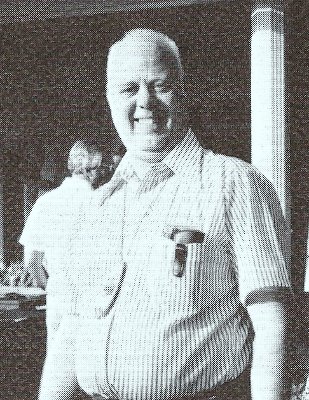
|
| 23 |
1967 -- Koji Hiramatsu was born in Japan. [Beginning in 1990, he would follow the
bonsai path, his father Kuniaki Hiramatsu, the third owner of the Shunsho-en garden, would be honing his eldest son's
skills from a young age as the heir to the famous establishment. He would grow up observing his father's advanced
technology closely. At the request of an enthusiastic customer, he would start shohin bonsai making and would
eventually act as the director of the Japan Shohin Bonsai Association as an official speaker. The family nursery
would deal with a wide range of bonsai, ranging from large dynamic specimens to palm-sized shohin, but they would be
focusing on shohin. Koji would be quoted as saying "Due to the housing situation and the aging population, we
are in an era where people prefer smaller sizes. The charm of small bonsai is that you can enjoy the atmosphere
of a big tree even in small size." For being small, however, this size would require more skill than the average
bonsai-like wire hook, but one-by-one is finished with excellent skill. His impeccable techniques, as a wire hook,
would be highly appreciated not only in Japan but also by his many fans abroad, and he would teach and care for bonsai
in countries around the world, often doing demonstrations in high level exhibitions. [A 50-year veteran at the office, he would support the Kokubunji bonsai culture with his younger brother, Kiyoshi. Koji would win the 2017 Japan Bonsai Sakufu Exhibition President's Award (Small Piece Category) and the 2019 Japan Bonsai Sakufu Exhibition President's Award (Creative Bonsai Category). He would be a member of the Japan Bonsai Cooperative Association and Nippon Shohin Bonsai Association, and be a board member of the All Japan Shohin Bonsai Association.] (Translation of Facebook post by Peter Ben, October 19, 2022, as reposted by Francisco Correa, November 24, 2022) SEE ALSO: Apr 10 1989 -- Australian teacher Leonard "Lenny" Webber died at age 80. (He became interested in bonsai while stationed as a soldier in the Occupying Forces in Japan after World War II, was one of the first Australians to take up bonsai after being exposed to it, and developed an extensive collection at his Sydney area home. He opened the Silver Bell Nursery in 1951. (The first Vita Koreshoff nursery was also opened that year.) Lenny eventually became a sensei at the Ryde Horticultural School in the late 1960s and awarded completing students two different TAFE certificates. His specialty was Ficus bonsai. He developed the Rainforest style, designed to emulate the tall, slender trees which grow in the rainforests as they reach for the available light at the top of the rainforest canopy. In 1969 at Ryde, Lenny presented, for the first time, a bonsai exhibition consisting solely of native Australian trees. About seventeen percent of the plants were Ficus species.) (In 1985, his Bonsai For the Home and Garden was published. Also that year, some of his collection was acquired by Ithaca College of TAFE in Brisbane for use as a teaching aid and was later moved to Grovely TAFE.) [While under the curatorship of TAFE, the staff and students would add a number of plants to the collection. In 1992 his From Rainforest to Bonsai: Bonsai in Australian Native Plants would be [re?-]published. The Brisbane Botanic Gardens - Mt Coot-tha The Bonsai House would be opened in November 1999 and be situated next to the Japanese Garden, an inspiring addition to the Gardens plant collections. The bonsai collection would be comprised of three separate groups which rotate on show. Unfortunately, many of Lenny's original trees would have died due to the change of climate but the collection would be built up over the years with the aid of local bonsai enthusiasts to further illustrate different bonsai styles and to display a range of suitable species of plants for bonsai. The decision to move the collection to the Brisbane Botanic Gardens Mt Coot-tha would ensure that Queensland residents and visitors had greater access to a large established collection of bonsai.] (Posting in AusBonsai.com by Grant Bowie, 23 Mar 2010; "Brisbane Botanic Gardens-Bonsai House Collection," http://www.bonsai4me.com/Gallery/GalleryBrisbanebotanic.htm; Webber, Leonard C. "Bonsai Group Research Exhibition," Bonsai Magazine, BCI, Vol. XV, No. 1, pp. 21-22; "Dennis McDermott, 2009 Ideas Summit Demonstrators, http://sob.ausbonsai.com/Nu2009_IdeasSummit_demonstrators.htm; "The Brisbane Botanic Gardens - Mt Coot-tha," http://www.bonsaishoponline.com/bia/country/au_qld/au_qld_botanic_garden.shtml; Australian Plants as Bonsai Study Group Newsletter, No. 4, June 2003, pg. 2 http://asgap.org.au/bonsai/apab-04.pdf; article with b&w photo of Webber here: http://trove.nla.gov.au/ndp/del/article/51588628?searchTerm=Leonard%20Webber%20bonsai&searchLimits=) SEE ALSO: Jan 28, Nov Also, Dec 16. 1998 -- Kai Kawahara, long-time sensei of the Rocky Mountain Bonsai Society (and Denver Bonsai Club before that) died a couple of weeks short of his 79th birthday. ("Persons born 05 January 1920 in the Social Security Death Master File," http://ssdmf.info/by_birthdate/19200105.html) SEE ALSO: Jan 5, FebAlso, Mar 18. 2024 -- Christopher M. Cochrane of Mechanicsville, Virginia died at age 75 of complications from a kidney transplant. The transplant itself was successful but Chris suffered several infections and other health problems that left him too weak to continue to fight. (In 1967 Chris graduated from Hermitage High School and then in 1971 graduated from the University of Virginia where he majored in Eastern religions. After several years of doing social work with the elderly, which always held a special place in his heart, he received a Master's degree in 1979 in Public Administration from Virginia Commonwealth University. He then worked in several state agencies as a classification and compensation analyst, a human resources director and consultant. While he enjoyed surfing and skiing in his early years, his true passions were travel and Asian Aesthetics, interests that began in college. He traveled extensively and cultivated lasting friendships in a number of states and countries. In 1988 he joined the Richmond Bonsai Society (whose website lasted from at least 2009 until it was shut down in 2020 early during the COVID-19 pandemic). In the RBS Chris learned the fundamentals of bonsai, enjoyed the company of fellow bonsai students, and served terms as secretary, treasurer and president. When the Internet became available in the early 1990's, Chris participated on a listserv that grew into the Internet Bonsai Club, a web-based discussion forum. (This is where RJB first communicated with Chris. He was always supportive of my historical research and promoted me among other enthusiasts so much that I respectfully referred to him as president of my fan club. In 2002 we met in person at the International Scholarly Symposium on Bonsai and Viewing Stones in Washington, D.C. It was at that venue that I became owner of one of the twenty copies of Dr. John Creech's The Bonsai Saga which Chris gifted to several of us, each copy signed by the National Bonsai Foundation's Dr. Thomas Elias and Felix Laughlin. In the mid-2010s, on a Saturday or other day that I was off work late morning and while I was working in my garden, Chris happened to call me. That call was one of the best telephone conversations I have ever had as we talked about bonsai and suiseki things deeper than any I had had or have had since. It was as if we were discussing meta-history, and I wish I could converse again at that level.) His interest in suiseki and viewing stones by the late 1990's led to him being co-chair of the Viewing Stone Mail List, and then him serving as a moderator of the Internet Bonsai Club Stone Forum. On this platform he would frequently add fascinating details to what other members posted including behind-the-scenes stories of the various large Japanese suiseki exhibitions and stone judging. He also served as the Webmail Correspondent for the California Aiseki Kai. From 1998 to 2023 Chris served on the Board of the National Bonsai Foundation, an organization that supports the U.S. National Arboretum's National Bonsai & Penjing Museum in Washington, D.C. He served as Secretary for 12 years and helped construct the Foundation's first website in 1998. In 1999 Chris was one of the four founding members of the Potomac Viewing Stone Group (PVSG), a Potomac Bonsai Association Club. He served as president from 2005 until his death. He co-designed with Glenn Reusch numerous PVSG exhibitions at the National Bonsai & Penjing Museum. Chris studied bonsai and suiseki in Japan for a year (2003-2004) at the garden studio of Kunio Kobayashi. He also studied display aesthetics, tea ceremony and Japanese Garden Design while in Japan. He was invited to contribute the section on bonsai included in The Oxford Companion to the Garden (Taylor, P., Ed., Oxford University Press, 2006). He maintained personal collections of bonsai and viewing and garden stones, one of which was featured in the National Bonsai & Penjing Museum's Chrysanthemum Moon Exhibit in 2007. Chris also contributed to Museum and NBF publication materials, including a profile on the La Bella Suiseki in one of NBF's newsletters. His sparse Facebook page was started in 2011. Chris was happiest in a river searching for viewing stones with friends, hiking in the woods, doing research on Asian Aesthetics, and sharing what he had learned with others. Most of all, he loved his family, his wife Susan Gholston (who he married in 2014), and the people who share his passion. 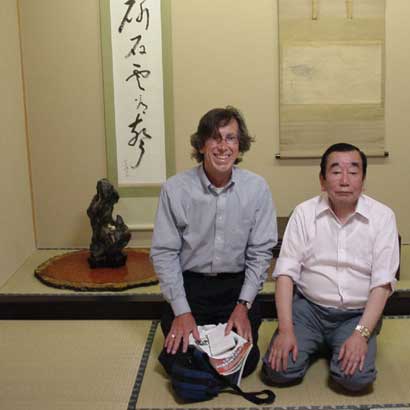
Chris Cochrane with bonsai and suiseki master Arishige Matsuura in Japan, 06/2004.
("In Memorium: Chris Cochrane," National Bonsai Fountaion,
January 10, 2025 ; "OBITUARY Christopher
Monteith Cochrane," Cremation Society of Virginia; "Chris Cochrane" Facebook page)
SEE ALSO: Apr 2, Oct 16, Oct 26, Dec 4, Dec 11, Dec 30
(Photo courtesy of Alan Walker, 05/11/07) |
| 24 |
1997 -- Second generation bonsai artist and master, Yuji Yoshimura,
"the father of bonsai in the non-Oriental world," died in Boston, Massachusetts at age 76.
(Profile of an Artist" by William N. Valavanis, Bonsai Journal, ABS, Spring 1998, pp. 8-9)
SEE ALSO: Jan 12, Feb 27, Apr 23, Jul 17
2003 -- Teacher Masaharu "Mas" Imazumi of Berkeley, California died at age 86. (Born in the U.S., he moved with his family to Fukuoka, Japan when he was three months old and lived there until he was thirteen years old. His father then moved them back to the U.S. where he served in the Army during WWII. He started gardening right after the war, the only way he could get a job. That led to interest in landscaping, and when a job in that field came up, Mas took it and started creating gardens, especially Japanese style ones. In 1955 Homei Iseyama was asked by Mas' year-old Fuji Bonsai Club (the second oldest in California) to teach them bonsai. (Mas had known and studied under Iseyama shortly before the Fuji club was started.) One rule Iseyama-san and the club had was that members were not allowed to teach outside the club. Respecting that rule and his sensei, Mas did not begin teaching bonsai until after Iseyama-san's death towards the end of 1975. At that time Mas arranged a retrospective show of Iseyama's work in San Francisco at the Miyako Hotel in Japan Town. Mas then taught all over the country and all over the world. At least five times he was demonstrator at Golden State Bonsai Federation conventions. He contributed articles to BCI's Bonsai Magazine and was the one of six persons thanked for advice and specimens photographed for the 1994 third edition of the book Sunset Bonsai. Mas retired on June 1, 2002 due to declining health during the past couple of years.) 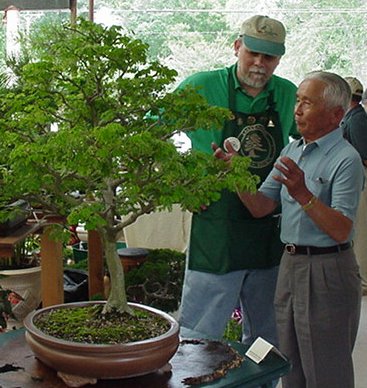
Mas Imazumi critiquing for Alan Walker, 05/14/2000.
(Photo courtesy of Alan Walker, 05/11/07) (Homei Iseyama, one of three early bonsai teachers in the San Francisco Bay area, was a teacher of Mas Imazumi. Iseyama, born in Japan in 1890 and a graduate of the Nippon Imperial University in Tokyo in the early 1900s, came to the U.S. as a banker but soon changed his calling to landscaping and bonsai. During WWII Iseyama was forced to leave his forty-year-old bonsai behind when he was forced by the U.S. government to move to the Abraham/Topaz Internment Camp just west of central Utah. "When he came back those trees had grown over six feet. His caucasian friends, who were taking care of them, didn't know how to care of trees, so they let them grow. When he came back, he saw those trees, and he had to restyle them completely." "...[Iseyama] was an artist in many fields - students have come from Japan to study under him; his paintings and sculptures are models of perfection. In Bonsai he specialized in maples, many of which graced his beautiful garden in Oakland. While in the Topaz Lake Internment camp he made his sculpturing tools from discarded files, etc., to continue creating beauty even under those distressing conditions. (He also made a teapot and 5 cups and suzuri (inkwells for calligraphy) out of local slate he found in the fields.) For years he taught Bonsai at the Fuji Bonsai Club in Berkeley and the Shikishima Club in Concord, California. He shared his vast store of Bonsai knowledge with many of the clubs of Northern California, and was the bonsai judge for the California State Fair for many years. The Bonsai Issue of the Journal of the California Horticultural Society, XXI #2 for April 1960 has a picture of his garden on the cover and an article which he wrote. He was the teacher of many of the best Bonsai teachers in Northern California...") (The Fuji Bonsai was founded in 1954 by Kusuo "Jimmy" Inatomi. Born in Honolulu in 1920 and moved to Japan when he was 3 years old, he also spent WWII in the Abraham/Topaz, Utah Internment Camp. He then settled in Castro Valley in 1950, when he started a nursery dedicated to bonsai. Inatomi continued to provide technical guidance to East Bay bonsai enthusiasts as late as 2010.) ("Mas Imazumi" by Boon Manakitivipart, Bonsai Magazine, BCI, Jan-March 2004, pg. 11; "Sad news" thread on bonsaiTALK.com, with pictures of Mas, http://forum.bonsaitalk.com/showthread.php?s=&threadid=5203, "Napa Valley Bonsai Club Newsletter," July 2002, http://www.napa-valley-bonsai.org/July%2002.pdf ; "In Tribute" submitted by Gil. Pitman, Bonsai Magazine, BCI, Vol. XV, No. 5, June 1976, pg. 158; "Masaharu 'Mas' Imazumi," excerpted from an interview by Jay Capachi on July 19, 1997, http://web.archive.org/web/19981206122925/http://www.acreagebroker.com/mas.htm; "Individual Record -- Homei Iseyama," http://www.familysearch.org/Eng/Search/SSDI/individual_record.asp?recid=556504852&lds=3®ion=-1®ionfriendly=&frompage=99; Kennicott, Philip "'The Art of Gaman': Life behind walls we were too scared to live without," The Washington Post, March 28, 2010, https://www.washingtonpost.com/wp-dyn/content/article/2010/03/26/AR2010032600115.html; "Agricultural Society of Japan Honors Bonsai Club Founder," 03-20-2010, http://www.hokubei.com/ja/news/2010/03/Agricultural-Society-Japan-Honors-Bonsai-Club-Founder; "MILITARY: Japanese Detention Camp (Abraham/Topaz) Higuchi-Ishida; Millard co., Utah," http://files.usgwarchives.net/ut/millard/military/jap-det/03.txt; http://files.usgwarchives.net/ut/millard/military/jap-det/code.txt ) SEE ALSO: Feb 28, Mar 4, Jun 17, Sep Also, Nov 3, Nov 6, Nov 20 |
| 25 |
|
| 26 |
|
| 27 |
1941 -- Mary Anna Holmes was born today, also her mother's birthday, in Syracuse,
NY. [She would grow up in Cazenovia, just a few miles south. After her father's untimely death
when she was 13, her mother would go to work for the Episcopal Diocese in Central New York while Mary would live
briefly with an aunt in Syracuse. After high school in Cazenovia she would go to Wells College, Aurora, N.Y.,
and "home" would move to Annapolis, MD, with her mother's reassignment. After college, then a few forays
into the job market, Mary would go to work at the Library of Congress in the
cataloging division. During a 12-year marriage she would become involved with the art of bonsai. The
marriage would end but bonsai would give her an expansive network of friends and activities. This would lead
to a Bonsai Clubs International Convention in July 1984 where a mutual friend would introduce her to photographer Peter
Bloomer. Their mutual interest in bonsai would lead to collaboration on a book about Timeless Trees, the U.S.
National Bonsai Collection in 1986. In the midst of that project, Peter and Mary would be married in
October 1985. Mary would go on to become president of BCI and a board member of the
National Bonsai Foundation. In Flagstaff, AZ she would continue
her library career with the Flagstaff Public Library. Upon retiring in 2002, Peter and Mary would move to
Sedona,AZ.]
(originally "Mary Bloomer, unknown [sic] - October 28, 2013" obituary, published in Cazenovia Republican on Nov. 14, 2013; Mary Anna Holmes Bloomer, Find-A-Grave) SEE ALSO: Oct 28 |
| 28 |
1999 -- A reception to honor Harry Hirao was hosted by Mr. James Folsom, Director of the Huntington Botanical
Gardens in San Marino, CA. Over 100 of Harry's friends were present to honor him on the opening evening
of California Aiseki Kai's tenth annual Suiseki and Viewing Stone Exhibition. Seven of Harry's very large
black Eel River Viewing Stones had been donated to the Golden State Bonsai Federation Collection at the
Huntington the previous summer. Each was now displayed on a large marble-like pedestal (plinth) in the
entranceway to the recently expanded bonsai display area. Touching of the viewing stones is permitted.
Harry Hirao, 10/12/2002.
("A Tribute to Harry Hirao" by Bill Hutchinson, Bonsai Today, 2000-5, No. 69, pp. 56-57)
SEE ALSO: Jan 1, Mar 12, May 9, Jul 23, Nov 3, Nov 6
(Photo courtesy of Alan Walker, 05/11/07) |
| 29 |
1960 -- Marc Noelanders was born in Eastern Belgium. [He would be influenced by
eastern mysticism that would drive him at an early age of 13 years to Karate. He would train for several
years up to the international level when his Master would want him to learn Bonsai to balance the ying and yang
of his personality. Marc would never look back. He would stay for a long time in Japan, initially
only watering, fertilizing and pruning trees in a standard program until he would be allowed to work on
trees. He would work under Japanese masters like Masahiko Kimura. He would be recognized by many,
including the late John Naka, for his comprehensive knowledge of the trees he works with, and for his ability to
capture perfection and yet maintain the ruggedness of his subject. Marc would teach throughout Europe and
in Russia, India, Canada, and the United States. He would demonstrate at conventions for the European Bonsai
Association (1992, 1995, 1999), Bonsai Clubs International (1997), International Bonsai Arboretum (1997), and
Golden State Bonsai Federation (1999). He would take care of the gardens of the Queen of Belgium, Arnold
Schwarzenegger, Al Gore, among others. His book Bonsai Art would be published in 1998 with forewords
by John Y. Naka and Paul Lesniewicz. Marc would pass on his knowledge and skill to small groups of pupils
during the weekends. His initiative would start the Noelanders Trophy in 2000 by organizing a contest show
for quality bonsai in a Japanese setting. A suitable venue would be found in the Convention Centre of the
Belgium town of Heusden-Zolder. The
first show would be very modest, however with
every year that followed it would be expanded both in space and quality of bonsai.]
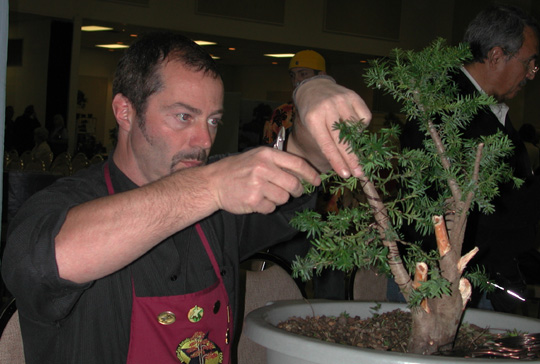
Marc Noelanders working on a Taxus, 11/17/2002.
(Balbir, Shyama "An Unforgettable Visit by Marc Noelanders," Indian Bonsai Association,
2007 Bulletin Board, pg. 9; "Marc
Noelanders To Be In Houston," Houston Bonsai Society,
Inc., August 2005 The Bonsai News of
Houston, pg. 1; "Anniversary of the Noelanders Trophy," Bonsai Focus, 2/2009, March/April, #120, pg.
44)
(Photo courtesy of Alan Walker, 05/11/07) |
| 30 |
1942 -- Thomas S. Elias was born in Cairo, Illinois. [He would attend
Southern Illinois University where he would receive undergraduate and graduate
degrees in Botany. In 1969 he would complete a Ph.D. in Biology from
St. Louis University with a dissertation on the taxonomic study of
the genus of plants in the coffee family. After completing his graduate work, he would become the
Assistant Curator of the Arnold Arboretum in Cambridge,
Massachusetts. During the years between 1971 and 1984, he would work as Dendrologist and Assistant
Director of the
Cary
Arboretum at the New York Botanical Garden, and hold the position of Adjunct Professor at the
College of Environmental Science and Forestry of Syracuse
University. In 1984 he would be appointed the Director of the Rancho
Santa Ana Botanic Garden in California and, at the same time, serve as Chairman of the Department of Botany
at the Claremont Graduate School in Claremont, California.
Dr. Tom would continue in both of these positions until he assumed his duties as the fifth Director of the
U.S. National Arboretum in Washington, D.C. on November 28, 1993.] [There, in addition to his many other duties, he would play a key role in the development and oversight of the National Bonsai & Penjing Museum. During his tenure as Director, the Museum would undergo considerable expansion of its physical plant and extensive expansion of its living collections, library, and museum artifacts. Dr. Tom would be instrumental in obtaining hundreds of rare and out-of-print books and serial publications, particularly from Japan, for the Museum's collections. He would serve since 2000 as the historian for Bonsai Clubs International's Bonsai Magazine, contributing nearly a dozen articles including the important two-part series "Mansei-en and The Kato Family" (2001). He would also serve as International Consultant to the World Bonsai Friendship Federation. A detailed History of the Introduction and Establishment of Bonsai in the Western World would be presented by him at the 2002 International Scholarly Symposium on Bonsai and Viewing Stones and then be expanded for the 2005 WWBF Convention, also in Washington, D.C.] [Dr. Tom would study the plants of Asia and North America for many years and be the author of at least seven books and over 130 scientific and popular papers and articles on wild plants, trees, and threatened species in America. He would win several awards and honors, including an honorary doctorate from the Russian Academy of Sciences in Moscow (2003) for his direction, over a period of more than 20 years, of a botanical exchange program between the United States and Russia (Soviet Union)] [Retiring from the National Arboretum at the end of 2009, Dr. Elias and his wife, Dr. Hiromi Nakaoji, would move to Claremont, CA. Their book, Chrysanthemum Stones: The Story of Stone Flowers would be published at the end of 2010. With Dr. Nakaoji, Dr. Tom would then start growing the awesome Viewing Stone Association of North America web site, developed in response to the growing interest in Asian and, especially, Chinese stone appreciation among English speaking audiences.] 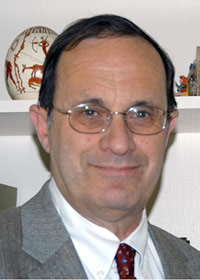
2007 -- Master Liu Zhongming died at the age of 82. (Born in July 1925, since the 1960s he had studied penjing creation for more than 20 years under the tutelage of Kong Taichu, the grandmaster of Lingnan Penjing, and then another two decades after Kong died. Master Liu created nearly one thousand pieces of unique Penjing compositions. In the 6th Hong Kong, Macao and Taiwan Penjing Art Fair, he won the "Highest Honor Award." For his outstanding contribution to China's Penjing industry, in 2000 Master Liu was awarded "Outstanding Penjing Artist of Cross-Century China." He was awarded the title of "Master of Chinese Penjing Art" in 2005, and the following year at the China International Penjing Stone Fair, he was awarded "Special Contribution Award.") 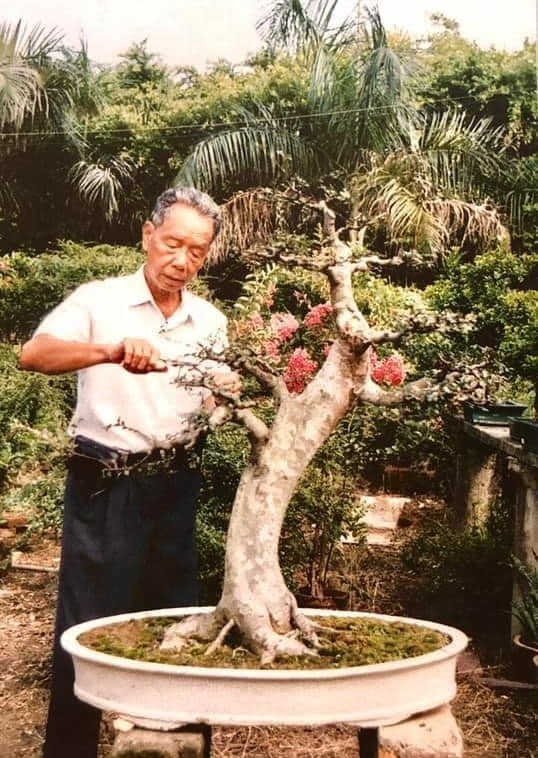
|
| 31 |
1961 -- The Midori Bonsai Club of San Jose, CA was founded.
("Who's Who in North American Bonsai,"
http://www.lost-oasis.com/bonsai/bonsai/wwnab.html)
1964 -- Yong Yap Chong was born in Kluang, Johar, Malaysia. [He would go on to become one of the best bonsai artists in his country, renowned for his extreme "surgery" technique on bending large branches and trunks of Wrightia bonsai resulting in 3D branching.] (Yong Yap Chong's Facebook page, accessed December 1, 2024 by RJB; Thomas Yuan's tribute video," September 2, 2024) SEE ALSO: Aug 28 2018 -- Greatly respected bonsai potter Dale Cochoy died peacefully in his sleep early this morning. The Ohio resident had battled cancer for several months, but had finished his final work and passed on his equipment earlier in the month. (Please see this tribute.) (John Romano post on Facebook, Dec 31, 2018) SEE ALSO: May 9 |
|
Also this month,
1989 - Suiseki popularizer Murata Keiji died of heart failure at age
63.
(Originally called Hanayashiki, the Murata family nursery was started in 1873 by Suzuki
Magohachi (1840-1903), who was the father of Murata Riemon. The family name Suzuki
was changed to Murata in Riemon's time, and later the nursery name was changed to Koju-en
based upon a recommendation made by Kido
Takayoshi, a well-known politician. Both Magohachi and Riemon had many rich and
famous customers, but they both concentrated on the business aspects of the nursery, rather
than stylizing bonsai. Riemon (1864-1936) played an essential role in the development
of bonsai in Japan. He organized the "Bonsai Club" which held a monthly exhibit of
dwarfed potted trees and published Bonsai Gaho as the club magazine beginning in April
1906. This was the first monthly bonsai magazine in Japan, selling over 3,000 copies
monthly through 1917 and issue #139. All the subscribers were members of the club.
After the Great Kanto
Earthquake in Tokyo in 1923, Murata Riemon helped the recovery of bonsai in
Tokyo. In cooperation with other bonsai nurseries in Tokyo, Riemon set up the Great
Japan Bonsai Encouragement Club and held an exhibit. This exhibition led to the
publication of the magazine Bonsai, with Kobayashi Norio serving as a chief editor for
the following 40 years. Riemon established the Tokyo Bonsai Alliance in 1933, with
Kobayashi Norio and others. Riemon served as the alliance's first president.
This organization later became the Nippon Bonsai Alliance, then the Nippon Bonsai
Cooperative.(Murata Kenji (1901-1992) was born in Tokyo. When he finished school he inherited the Kojuen, a bonsai business enterprise, becoming the third head in 1936 after his father Riemon passed away. While devoting himself to bonsai and suiseki, he exerted great effort toward the founding of the Tokyo Bonsai Club and the Japan Bonsai Union. Between 1956 and 1965 his nursery published the 10-volume work Bonsai: Photographs of Now Famous Miniature Trees. Kenji was one of the three founding members of the Nippon Suiseki Association in 1961. Three years later, he was named the permanent advisor to the Bonsai Union and to the Japan Suiseki Institute. He helped pioneer the stone boom of the 1960s and 70s there.) (Born in 1926, Keiji was the first son of Murata Kenji. Keiji went on to author, co-author, and edit at least 30 books and many articles on the practical aspects of collecting, displaying, and appreciating suiseki, all in Japanese. His first book, Modern Suiseki Illustrated, was published in 1962. He started the Juseki Company in 1964 to publish the monthly magazine Juseki (Trees and Stones) and also books on stones. The first issue of the magazine was published in May 1964. It was renamed Aiseki-kai (Aiseki World) with the April 1971 issue. The intent of changing the name of the magazine was to broaden the scope of the magazine to cover biseki (beautiful stones), chinseki (Chinese stones), fossils, minerals, abstract stones, and garden stones. The 200th issue of Aiseki-kai was published in August 1980. In that issue, Yamamoto Goro, the chief editor of the magazine, wrote an article to reflect his work at the Juseki Company with Murata Keiji. Yamamoto wrote that suiseki in 1980s Japan became subordinate to bonsai, and there were many people who talked about the theories of suiseki. Stone hunting in Japan became more popular, rather than the purchase of stones from dealers. The Juseki Company, headed by Keiji, published Aiseki-kai magazine until the end of 1981. The periodical then began to be managed and published by the Aiseki-kai Company starting in January 1982. Keiji decided to part ways with Aiseki-kai because he saw the saturation of the sales of the suiseki magazine and decided to publish Bonsai Sekai (Bonsai World) in 1980. Bonsai became the main hobby among the general public in the 1980s in Japan. After Keiji left, Aiseki-kai continued to be published until the last issue in December 1988. A group of his friends started the New Juseki Company later in 1989 to publish the new Juseki magazine in October 1989. Keiji returned to take the position of chief editor for the magazine. It was an exciting opportunity for him with high expectations and hopes for the new magazine. Alas, two months later he was gone.) [Had Keiji not died three years before his father, he probably would have taken over the family business of running the bonsai nursery. In February 1990, two suiseki exhibits would be held in Tokyo to commemorate Murata Keiji, and Juseki #5 issue would be especially dedicated to him. The Juseki Company would publish additional books on Japanese stones by other authors. In 1989, what would be Keiji's final book, The Beauty and Heart of Suiseki, was published with a limited issue of 350 copies. Fortunately, Sekine Keiji, the president of New Juseki Company, would reprint the entirety of this work in the Juseki magazine between the 2008 February and the 2009 February issues.] (Nakaoji, Hiromi "The Murata Family's Contribution to the Development of Japanese Suiseki," VSANA, July, 2021, this very comprehensive article contains more information, especially about Keiji and has 10 color photographs of suiseki and book covers; dustjacket of Practical Bonsai for beginners; Wil in Japan, "The Nature of Suiseki in Japan"; Japanese Book Reviews," VSANA) SEE ALSO: Apr 1, Aug 27, Sep 1, Dec 11, Dec 30 2000 -- Oscar Jonker, 15, started building a website to explore his technical skills and to further his interest in bonsai. (Having a little experience with judo, he started learning karate after seeing The Karate Kid. About a year later he came upon a beginner's tree in a big box store. Oscar had already been growing herbs in his parents' garden. He soon happened to get a piece of software to make a simple website, and decided to make one about his recent new interest: bonsai. (Having made a couple of initial attempts with other names the month or two before, "Bonsai Empire" was the chosen name for this little project officially launched near year end. The initial site was written in Dutch, and within a few weeks Oscar included an English version.) [He would graduate with a Bachelor and Master degree in Economics gotten at Rijksuniversiteit Groningen, with a brief stay at Hong Kong Polytechnic, cum laude, and grow up in the east of the Netherlands. The website would go on to live up to its grand name. A Facebook page would be created June 2, 2010. Oscar would first contact RJB via Facebook Messenger that Christmas when the former noticed similarities between our "Bonsai Enthusiasts" pages and his own spreadsheet about the extent of interest in Europe. By this time Bonsai Empire would have over a million page views annually. A German language version would have been just added, with a Spanish one to follow in about a month, and then the Italian version. Then asked by Oscar to write a new level of introductory material for Bonsai Empire, RJB's original article "History of Bonsai" would be published (and then translated) on January 24, 2011 and followed by "What Is Bonsai?" on April 14, 2012. That year the Facebook page would exceed 10,000 fans and Oscar would have been putting videos on YouTube for perhaps a year. The middle of December Oscar and RJB would start to collaborate on an article, "How Big Is Bonsai (And Related Arts) Worldwide?," the first edition of which would be published April 4, 2013 in the site's Forum, with a posting to the Internet Bonsai Club. A second edition was published August 5, 2013. By this time, Bjorn Bjorholm and then Michael Hagedorn would be the first two masters Oscar would work with to create online courses. Material from RJB's three articles would be included with other material in the August 21, 2014 e-book Bonsai: A beginner's guide. Oscar would report from the Artisans Cup in September 2015, the 5th U.S. National Exhibition a year later, and the 6th U.S. National Exhibition in 2018. Bonsai clubs, shops, nurseries, and potters around the world would be listed by location by the Spring of 2016, partly based on Oscar's early club listing and thoughts off of the "How Big" article. Soon after this Oscar would be able to dedicate his attention full-time to Bonsai Empire, the beginner and then intermediate, and eventually advanced courses sufficiently monetizing the website. (He would have been doing some freelance web and digital work on the side.) A large update to the e-book would be published in November 2017. Sales would be especially popular on Amazon.com. In 2018, Oscar would be interviewed for Episode 6 of Bjorn's Bonsai Network Podcast while they were both in India for a Bonsai Namaste convention. At that time there would be 12 languages on Bonsai Empire, seen by a million visitors a month. [By 2020 the website would be in 15 languages, translated by a team of people interested in bonsai. Experts would write many of the blog articles (such as my "Synergy of miniature landscapes" contribution in April 2010). Freelance digital and video persons would round out those who helped maintain and grow the website, with Oscar travelling extensively, shooting photographs and footage, and conducting interviews. The crown jewel -- to-date -- in Bonsai Empire would be the detailed 14-part 4-hour-long online bonsai master class course conducted by Masahiko Kimura, who is regarded as the world's premier artist. As Oscar would explain, they "had the privilege to visit Mr. Kimura's garden for various occasions to conduct interviews and even shoot an exclusive short film with him. Through our interactions over the last few years Bonsai Empire has been slowly gaining his trust and building a good relationship." This would be just another reason why the website would be so highly regarded worldwide as the number one online source for quality bonsai information. The Forum section of the website, especially, would be very actively participated in. Nearly 400 videos would be available on YouTube by the 20th anniversary of Bonsai Empire. The Facebook page would have over 200,000 followers by then. In January 2021 the Wikipedia article about them would be published. (That article was subsequently rejected by editors who claimed it was merely an advertisement!?) An accepted version of the article is at Fandom.com's Bonsai Wiki. Oscar would describe himself as a bonsai hobbyist who is a facilitator of the website which is especially appreciated by beginners and has many persons repeatedly viewing/reviewing videos as their skills with bonsai progress. In his downtime, he would enjoy both indoor and outdoor rock climbing.] 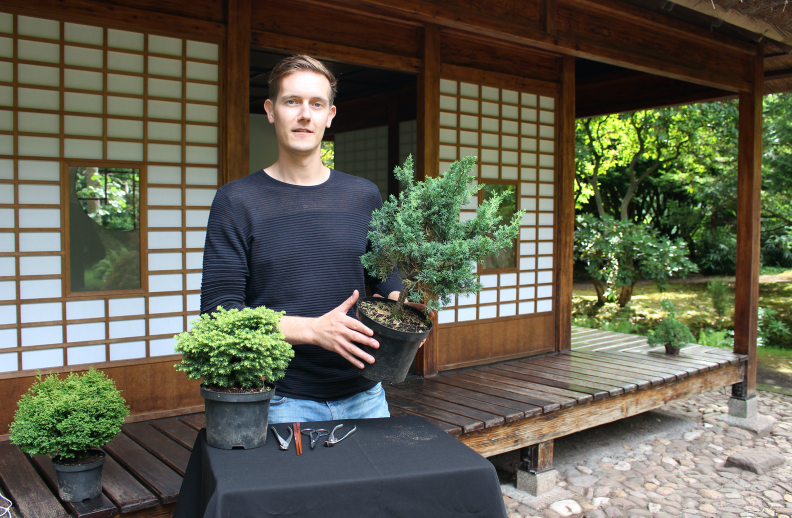
Oscar Jonker
(RJB Conversation with Oscar on Google Meet, 12/12/2020; FB Messenger archives for RJB; photo on Messenger from OJ
12/27/20;
"Creation
#275. Bonsai 24. Congratulations to Bonsai Empire!," circadian creative, October 2, 2012;
"Mr
Kimura Masterclass, there's a buzz all over the Bonsai world and it's coming from Bonsai Empire," Matt's
Bonsai Blog, May 30, 2020.) SEE ALSO: Mar 31, Apr 23, Apr 25, Sep 25
2013 - The George Weyerhaeuser Pacific Rim Bonsai Collection was spun off as a separate nonprofit corporation and supporting organization of The Greater Tacoma Community Foundation. (The bonsai collection had first opened in 1989, in conjunction with the Washington state centennial celebration. It features outstanding bonsai trees from Pacific Rim nations and is praised as one of the top bonsai collections in the country. Closed due to the depressed world economy from April 2009 through the summer of 2010, the collection was reopened at the basic services level (no money was being spent on extra lectures, advertising, or off-site displays). Weyerhaeuser in 2013 thought that the collection of 100 miniature potted trees -- 60 on display at any given time -- could be run better by someone else. The collection was a department of the timber company, but would transition to an independent entity with a non-profit status. Other organizations were designed to promote and market and really highlight a collection like that in a way that Weyerhaeuser was not. In addition, the collection was costing the company hundreds of thousands of dollars to maintain. Weyerhaeuser had sent out requests for proposals to determine where to donate the collection. Responses were due in September 2013, and the timber company would also consider an endowment for further financial support.) [At year end, the donation was made and "allows for the collection's storied history with the Weyerhaeuser Company and the South Sound community to continue, and ensures the protection of this significant collection for decades to come." As a supporting organization, the bonsai collection is a separate legal entity and eligible to be qualified as a section 501(c)(3) organization with its own governing instruments and its own board of directors, the majority of whom the foundation will appoint. The Bonsai Collection joins Lakewold Gardens and the Western Forest Industry Museum as the Greater Tacoma Community Foundation's third supporting organization. [The bonsai collection would remain at Weyerhaeuser's corporate headquarters in Federal Way, WA. Currently, the bonsai collection attracts more than 30,000 visitors annually. In addition to support from Weyerhaeuser, the foundation was awarded a $142,000 grant from the Donald R. and Mary E. Williams Horticulture Fund to assist the bonsai collection in achieving self-sufficiency. The collection would be renamed The Pacific Bonsai Museum (PBM) and the original curator, David DeGroot, would retire in the Fall of 2014. Aarin Packard, the assistant curator of the National Bonsai and Penjing Museum in Washington, DC would be appointed the first curator of the reborn Pacific collection of over 100 trees. The Museum's Facebook page would date to October of that year.] [In August 2014, the Weyerhaeuser Company would announce their intent to sell their corporate headquarters to move to Seattle. On February 9, 2016, the PBM would receive word that the campus had been sold to Industrial Realty Group, LLC (IRG), which would allow the collection to remain. Dedicated to being the preeminent bonsai museum in the world, PBM would aim to grow their premiere collections in surprising directions, present groundbreaking exhibitions and offer engaging opportunities to experience and explore this ancient art form. They would plan to dramatically increase their impact by growing and diversifying the Museum's collections; by educating people about bonsai art, culture and traditions; and by creating community. They would envision expanding facilities, offering rich, diverse education and outreach programming and investing in technology to further their commitment to access for all.] (Hobbs, Andy "Weyerhaeuser wants to donate Pacific Rim Bonsai Collection," Federal Way Mirror.com, Sep 16, 2013, http://www.federalwaymirror.com/news/223997901.html; "Weyerhaeuser donates Pacific Rim Bonsai Collection to Tacoma foundation," Federal Way Miiror.com, Feb 19, 2014, http://www.federalwaymirror.com/news/246188891.html; "The Pacific Rim Bonsai Collection" Internet Bonsai Club post by Victrinia Ridgeway on Wed Jun 16, 2010; Curator Position Opening -- Pacific Bonsai Museum (formerly Pacific Rim Bonsai Collection)" Internet Bonsai Club post by Roger S Case on Mon Jul 14, 2014; "Transition FAQs", Pacific Bonsai Museum) SEE ALSO: Jan 26, Mar 8, Apr 2, Oct 7 |